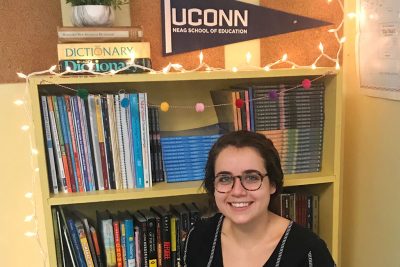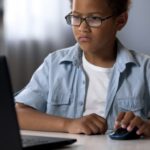Editor’s Note: This article, written by Jessica Stargardter, the Neag School’s 2020 recipient of the Early Career Professional Alumni Award, originally appeared on the National Association for Gifted Children’s website.

Now is an important time to remember our gifted learners.
Schools everywhere have closed their doors, and many gifted students find themselves without rigorous work and the camaraderie of their peers. It is up to us to continue to nurture the development of our brightest young minds with learning opportunities, and it is time to collaborate, especially given our social distance.
Gifted learners are easily overlooked. There are few mandated services for them, and those that are in place are less stringent than for other populations. The National Association for Gifted Children (NAGC) reminds us we must provide spaces for our students that “foster growth” and “positive social interaction” (NAGC, 2019). We can no longer create comfortable physical spaces for our kids, so virtual instruction is central to achieving this end.
It is up to us to continue to nurture the development of our brightest young minds with learning opportunities, and it is time to collaborate, especially given our social distance.
Jessica Potts, a Ph.D. with a focus on gifted education and online learning, recently made the case that “virtual classrooms are uniquely situated to serve the needs of gifted students in particular” (Potts, 2019). Online learning presents the opportunity for gifted students to shine. We can provide learning environments that foster academic growth and positive social interaction from a distance.
As a teacher in a district who is required to teach online, I recently sat down and compiled a list of helpful tips to service gifted learners with remote instruction:
1. Enrich First, Then Accelerate
In the beginning of distance learning, it is important to focus on enrichment over acceleration. Ideally, educators provide activities that are engaging. While virtual learning is not new in the gifted education world, this can feel like a big undertaking for teachers and students. Enrichment activities allow students time to reacclimate to an online education before introducing new material.

Enrichment activities may include virtual field trips, videos, articles, mini-projects, and podcasts. Choice boards and playlists are also great ways to push out enrichment activities. Adding choice to learning opportunities will increase engagement.
As Potts points out, virtual classrooms can be a plus for our gifted kids (Potts, 2019). These asynchronous learning opportunities accommodate students’ learning needs by providing opportunities to work at their own pace.
Distance learning is a great time to provide Type I experiences as detailed in The Enrichment Triad Model developed by Joseph S. Renzulli in 1977. Type I experiences are general exploratory activities that spark an interest (e.g., an interview with a guest speaker). Hundreds of professionals are quarantined in their homes, looking for something to kill the time. We can take advantage of this unique opportunity to create authentic learning experiences for our students.
As my students and I become more comfortable with remote instruction, I will add accelerated learning opportunities to the curriculum. Many gifted students will crave mental stimulation quickly after starting distance learning. It is important to plan how to curriculum compact in distance learning. Plan to collaborate virtually with grade level and content area teachers to provide enrichment and acceleration resources as needed.
2. Organization Is Key
In any classroom, staying organized will make learning more efficient and effective. Keeping track of assignments, attendance, and grades is difficult even when you have the students right in front of you. Add a few miles between you and your students and organization becomes imperative.
Google Classroom is a great platform to systematize assignments and keep students up to date. Educators can collaborate by adding each other to their Google Classroom. This enables teachers to coordinate with grade-level teams or subject level teachers to provide more rigorous learning opportunities.
Gifted learners may be eager to start their assignments or finish them quickly. Through Google Classroom, teachers can leave optional enrichment activities for students to complete. Links to extension activities can foster growth during distance learning after the virtual school day is over.
Distance learning is a great opportunity for you and your students to take risks, reflect on the journey, and learn a lot.
3. Communication, Communication, Communication
Gifted students can have a variety of social and emotional needs. During a stressful time with many unknowns, students may feel anxious. We can alleviate some of that anxiety by providing gifted students access to their peers and teachers.
Studies show that gifted students in homogeneous groups perform better academically than their peers in heterogeneous groups (Davidson, Davidson, & Vanderkam, 2004; Gentry, 1999; Webb, Gore, Amend, & DeVries, 2007). While virtual instruction may lack frequent face-to-face interactions with like-minded peers, we can provide learning opportunities where students interact.
There are many ways educators can foster a collaborative online learning environment. First, provide students with a way to connect with you online. I provide my email address, an open discussion post on Google Classroom, and Google Hangouts Group Chats. Depending on district privacy rules, video chatting may be another way to communicate with students.
Second, allow students to connect with each other. Encourage students to pick a class “buddy,” so they can discuss assignments together. Video and group chats give gifted students much-needed contact.
Finally, educators can use this time to try something new. Distance learning is a great opportunity for you and your students to take risks, reflect on the journey, and learn a lot. Tech tools like Padlet and Flipgrip allow students to comment on discussion posts via video or text and reflect on their learning. This brings me to my last tip.
4. Use Tech Tools
There are so many resources available right now for educators to use during distance learning. Many EdTech companies are offering free premium accounts for the time being. Below is a list of tools I’ve found helpful and will continue to use over the coming weeks.
Description
- Free Online Courses
- Student Engagement Platform
- Student Engagement Platform
- Video Conferencing App
- Student Assignment Platform
- Video Recording Platform
- Collaborative Discussion Platform
Ways to Use With Gifted Students
- Review, Enrichment, Acceleration
- Live lessons aligned to curriculum standards
- Pair with Google Slides and Google Meet, Interactive and engaging slideshows for mini-lessons
- Socratic Seminar, Debate
- Discussion Posts
- Book Talks, Explain Math Thinking
- Book Recommendations, Critical Thinking
Jessica Stargardter ’16 (ED), ’17 MA, a gifted and talented teacher at Norwalk (Conn.) Public Schools, was named the 2020 Outstanding Early Career Professional by the Neag School of Education. This piece has been republished with permission.
References
Davidson, J., Davidson, B., & Vanderkam, L. (2004). Genius denied: How to stop wasting our brightest young minds. New York: Simon & Schuster Paperbacks.
Gentry, M. (1999). Promoting student achievement and exemplary classroom practices through cluster grouping: A research-based alternative to heterogeneous elementary classrooms (99138). Storrs: University of Connecticut, National Research Center on the Gifted and Talented.
National Association for Gifted Children. (2019). 2019 Pre-K-Grade 12 gifted programming standards. Washington, DC: Author.
Potts, J. A. (2019). Profoundly gifted students’ perceptions of virtual classrooms. Gifted Child Quarterly, 63(1), pp. 58–80.
Renzulli, J. S. (1976). The enrichment triad model: A guide for developing defensible programs for the gifted and talented. Gifted Child Quarterly, 20(3), 303–326.
Webb, J. T., Gore, J. L., Amend, E. R., & DeVries, A. R. (2007) A parent’s guide to gifted children. Scottsdale, AZ: Great Potential Press.
 Facebook
Facebook
 Twitter
Twitter
 LinkedIn
LinkedIn
